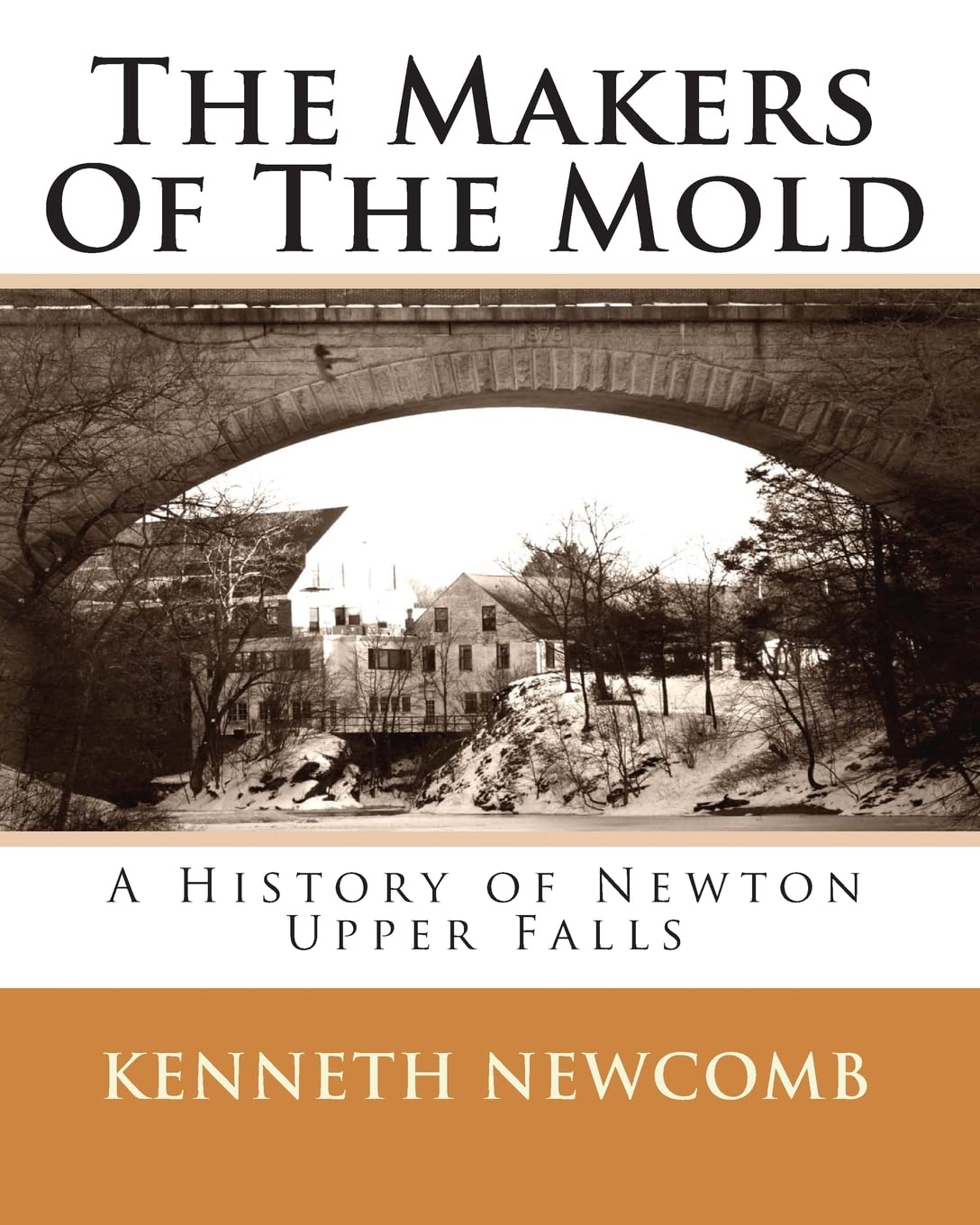Puritan Beginnings
The religious development of the village began under the influence of the Puritan or Congregational church which was the official state church and was the religious preference of the Massachusetts Bay Colony of which Newton was a part. This was simply the result of the fact that the first two permanent settlements in New England were under the direction of the settlers of that persuasion; at Plymouth in 1620 by the so-called Pilgrims, and Boston in 1630 which became the center of the Massachusetts Bay Colony’s influence. While the philosophies of the two groups differed slightly, when they merged as one colony in 1691, many of the tenets of each group had been accepted by those within the consolidation.
From THE GROWTH OF THE AMERICAN REPUBLIC by Samuel Eliot Morison (and others) – Oxford Press – 1980, we learn:
“The Puritans were that party in the Church of England who wished to carry through the Protestant Reformation to its logical conclusion, and establish both a religion and a way of life based on the Bible – as interpreted by themselves. The Church of England, an English compromise between Rome and the reform, did not satisfy them. With official Anglican doctrine the Puritans had no quarrel, but they wished to do away with bishops, deans, and all the clergy above the rank of parish priests, to abolish set prayers, and to reorganize the Church either as a hierarchy of councils (Presbyterianism), or on the basis of a free federation of independent parishes (Congregationalism). They were disgusted with the frivolity, extravagance, and moral corruption that pervaded both extremes of English society in the early Stuart era…In other words, they wished to establish such patterns of behavior as would make it possible for people to lead something approaching the New Testament life…English Puritan doctrines frowned on idleness as a sin…and taught that a good businessman served God well, provided he were honest; hence Puritanism appealed largely to the middle class of tradesmen and rising capitalists whose center was London…And it enlisted the devoted support of many young intellectuals in the universities, especially in Cambridge; hence the stress of Puritans on education.”
As the Puritan influence was to remain to this day in our form of government, education and religion, it might be well to understand a little about its beginnings in New England.
The Massachusetts Bay Colony was a Puritan experiment established and paid for by themselves, similar to other colonies in this and other countries founded under church influence. The Puritans would exercise complete control over its operation until after 1686. Morison once declared, “A good deal has been written about their narrowness, bigotry and intolerance, the natural defects of their zeal and passionate faith. They were trying the experiment of a Bible colony, and believed that disturbers of their peace ought to find colonies elsewhere – there being plenty of space available.” Regardless of our feelings about the philosophy of the Puritans, their cultural achievements in a raw, new country were remarkable (See Chapter 1, Historical).
Because of their desire that every child be taught to read, every town in 1642 was ordered to establish a free public school with the result that Boston Latin School was founded as early as 1635 and Harvard College in 1636. Other schools followed, all aided by the establishment of the first printing press in the colonies in 1638.
In Puritan fashion, residents of Newton had followed the general pattern of setting up one church supported by public moneys. Following the practice at that time, the church became the seat of government in the community. It was located in the parish of East Parish (Newton Centre) and was to occupy two temporary sites before settling in a permanent location on Centre Street. A town meeting held in January 13, 1661 authorized its initial construction, and the first site it occupied was near the center of the old cemetery on Centre Street now marked by a marble column erected in September, 1852 in memory of the first settlers. The church was organized July 20, 1664 with 80 members and its first pastor was Reverend John Eliot Jr., son of the famous apostle to the Indians.
The second meeting house was approved by the voters in 1696 after Newton had separated from Cambridge, and the building was completed in the early days of 1698. It stood on the westerly side of Centre Street opposite the cemetery. In 1781 the third meeting house was built on a site which, apparently after some discussion, was selected by a committee of the General Court to whom the matter had been referred for decision. Subsequent churches replaced this building, but all were built on the same site on Centre Street near the center of the village. For almost 175 of its 312 years, the church played a dual role as a house of worship and a seat of colonial and town government, representing the colony in its spiritual as well as its political endeavors. In the Puritan tradition the two functions were equally sacred.
In 1764 a group of Puritans or Congregationalists at West Parish (West Newton) built a church and petitioned the General Court to divide the town into two parishes, east and west. An Act of the Court to establish West Parish was finally passed in October, 1778 and the division was made as follows:
“Beginning at the bank of Charles River, at the south-east corner of a farm possessed by Samuel Woodward, thence by direct line to the south-east part of the land improved by Daniel Fuller, and to continue the same straight course t o Watertown line. The inhabitants on either side of the line may choose to belong to either Parish, provided they make their election, and give their names to the office of the Secretary of State, within six months after the passage of this Act.”
Their church was dedicated in 1781. The older church at East Parish (Newton Centre) would continue to be the seat of town government over both parishes. However, this split into two parishes was probably the basis for the political battle between the two villages some fifty years later.
Other Churches Appear
The older church began to suffer periods of stagnation as the result of being a monopoly. Their troubles began in 1740 with the appearance of a fresh, new face in the pulpit. George Whitefield, the noted revivalist preacher of the day who, like his close friend and co-founder of the Methodist movement John Wesley, had not laid aside his robes as an Anglican priest but used the established pulpits of his day to proclaim his message. It was later that Jesse Lee and Francis Asbury would ride their circuits seeking converts to the new Methodist Church – the first of which in New England appears to have been established in 1791 in the old Needham Congregational Church on Blossom Street (now Weston Road, Wellesley).
S.F. Smith, a Baptist minister who will be remembered as the author of the patriotic hymn, “America,” writes in his HISTORY OF NEWTON (1880) that Whitefield’s eloquent preaching in the 1740s in the old church “aroused the people from a dead formalism” to a point where many of them became disenchanted with the church and eager to meet Whitefield’s challenge “to show more evidence of personal piety and make a more creditable profession of their faith.”
The result was that many left the church to form in Newton and adjoining towns. “Separate” or “New Light” churches. Smith explains, “The name was given them as a term of reproach, as if they pretended to have received ‘new light’ from heaven. A church of this faith formed in Newton, meeting in the home of one of its members, Nathan Ward, who later became their pastor. He was one of Whitefield’s converts.” However, despite Reverend Ward becoming an ordained minister he was still required to pay a ministerial tax to the town of Newton, though the law exempted from taxation all ordained clergymen. He protested to the town that this treatment was unlawful and sent an open letter of complaint to the town meeting of March 3, 1755. Unsuccessful, in the winter of 1763-64 he removed with his family from Newton where he felt he was being persecuted, to a pastoral charge in Plymouth, New Hampshire.
Later, most of the “New Light” congregations merged with the Baptists, the only other sect in Newton, whose pastors and members were also demanding they be exempt from paying ministerial taxes. Two prominent industrialists, Jonathan Willard of Newton Lower Falls and Noah Parker of Newton Upper Falls, led the opposition, Willard having joined the Baptist Church in Boston in 1729 and Parker the same church in 1749. Both petitioned the town that they be released from paying the tax but their request was denied. During the next 25 years many other Baptists made similar appeals but were voted down by the town. However, in 1776, James Richards and Edward Hall made a like request and had their petition granted.
This prompted the Baptists in Newton to make immediate preparations to establish a church in the town. In 1781 their first church was erected by the side of Baptist Pond (later Wiswall’s Pond and still later, Crystal Lake). A question might he raised here, should credit be given to “Methodist” George Whitefield for this ecclesiastical achievement?
Following his preaching in Newton, Whitefield moved on in 1740. Francis Jackson of Newton, in his HISTORY OF NEWTON (1854) through the use of a quotation from a historical publication of the day, traces further activities of this remarkable preacher:
“Same year (?), he preached in Boston. The meetinghouses not being large enough to hold his audiences, he preached on the Common to five thousand persons, then to eight thousand, and in his farewell sermon to twenty-three thousand persons. It is almost needless to observe the benefit achieved by his visit.”
Snow’s History of Boston
Returning to S.F. Smith, he tells us in his history that sometime in 1747 Whitefield returned to New England and preached in Newton “before crowded and attentive audiences.” His final sermon here was preached on September 20, 1770 in the Puritan or Congregational Church. His last sermon was given but a few days before his death in Newburyport.
The End of State Religion in Massachusetts: 1833
The year 1800 found but three churches in Newton. However, with the advent of the industrial revolution it was inevitable that other emigrants with matching zeal for their own beliefs would be attracted to the job opportunities in the industrial villages. This would force, over time, some of the Puritan’s extreme tenets to be considerably modified as their absolute control was challenged. The end of the state church in Massachusetts would come, however slowly, with the passage of the Bill of Rights following the adoption of the nation’s constitution after the Revolutionary War. The first of its ten amendments which read (in part) “Congress shall make no law respecting an establishment of religion, or prohibiting the free exercise thereof…” was part of a document that Massachusetts had urged be adopted while delaying until 1833 the repeal of its law that had established the Puritan church as the official church of the state.
However, Newton’s Puritan or Congregational church found that it was going to be difficult to give up the seat of government to the town. It is a story hard to believe, and Smith’s HISTORY OF NEWTON devotes a considerable amount of space to it.
“In 1830 some time after the separation of the ecclesiastical from the civil state in the Commonwealth of Massachusetts ‘the proprietors of the First Parish meeting-house objected to having the town meetings held there.’ However this objection was being made after ‘it had been used by common consent and without objection, for twenty-five years both as a parish house and a town-hall. Now the proprietors deemed that the time had come when the town ought to have a place for holding its meetings which should be provided at the town’s expense, and be under the town’s control’. “
The first question the town must settle was; if a town hall was built, where should it be located? It was soon obvious that West Newton and Newton Centre would be the leading contenders in supplying the location of the building, and these two villages settled down to do battle, one that would not be settled until 1848-49 with the final last flames of contention being stamped out in a town meeting of March 12, 1855!
In the beginning, they were faced with two options – divide the town into two independent towns or erect two town halls. These alternatives were argued for several years and a number of meetings in 1833 (held in the Baptist meeting house in Newton Centre) failed to settle the issue and the matter was deferred “to the next meeting” where always a new solution was presented. On one occasion when it looked as if Newton Centre had won out, a group of its citizens raced to get some timber to a location of their choice but they had just got construction started when unfavorable weather held them up, long enough for another meeting called on February 8, 1834. At this meeting it was voted “to build a town-house at Newton Centre, nearly opposite the old Baptist meeting-house and also pay the corporation of Fuller Academy (West Newton) $100 toward building a suitable hall and that the town meetings be held alternately in those two places.” Fuller Academy erected the hall, fitted for the uses of a town meeting. However, something went awry, as we learn that during the years 1835 to 1837 the town meetings were held in the town-house near Newton Centre.
For a while other matters took all their attention including again the subject of dividing the town, a matter that went as far as being referred to the Legislature. A committee of the Legislature favored the division and reported a bill to that effect, but the heroic efforts of the Reverend Samuel P. Skinner of the Upper Falls Universalist Church prevailed with his eloquent plea against division in a town meeting was heeded and the town remained undivided. (See under U.F. UNIVERSALIST CHURCH). At a town meeting held March 25, 1844 majority and minority reports were presented by a committee previously chosen. Both recommended that the town-house be erected in West Newton, their only differences were regarding its location. In 1845 one more attempt was unsuccessfully made to divide the town and the contest was continued until 1848-49, when it was again voted by the town to hold the town meetings in West Newton. The old Second Congregational meeting-house was purchased for $1,800 and fitted up for a town-hall. It was enlarged later and when Newton became a city in 1874 it became the City Hall.
Nevertheless, it wasn’t until March 12, 1855 that the Honorable David H. Mason moved “that the inhabitants of Newton will oppose any and all measures for the division of the town, and that they will regard with disfavor the disturbance of their peace and harmony by the further agitation of the subject.” “The motion was carried by a very large vote, probably four-sixths of the whole voting.”
Growing Diversity
By 1833 there were a number of churches of many faiths that were girding up to serve a new nation. It is recorded that there were about 25,000 Catholics in America at the beginning of the Revolutionary War as well as 2,000 persons of the Jewish faith. Religious freedom was now available to all.
It should be noted here that whatever opposition that we might have heard existed between the Puritan and the Roman Catholic church did not seem to be in evidence in the late eighteenth century as we note this observation by historian William Muir Whitehead:
“When Father Cheverus, the beloved priest, who became the first Catholic Bishop of Boston, undertook in 1799 to build a church, Bulfinch generously gave the plans. In such esteem was Father Cheverus held that President John Adams headed the subscription list for the building which eventually raised seventeen thousand dollars (a sizable sum in those days), much of this coming from local Protestants. The Cathedral of the Holy Cross, on Franklin Street, was consecrated on Sept. 29, 1803. In grateful recognition of Bulfinch’s help the Catholics of Boston presented him with a handsome tea-urn, now in the Museum of Fine Arts…”
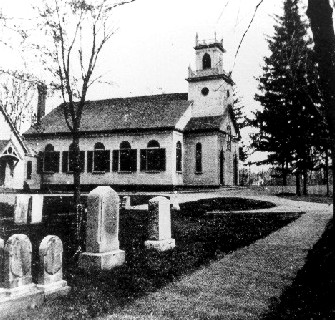
After the turn of the century, a Church of England congregation emerged and built their church in Lower Falls in 1814, a church that still stands as Newton’s oldest. Within 30 years five other denominations had erected churches in Newton Upper Falls; Unitarians, Methodists, Baptists, Universalists and Catholics. For a brief time in 1830-1831 the Congregationalists had joined with the Baptists in a joint religious venture in the village. It is also recorded that in 1845, when the Eliot Church was formed in Newton Corner, the number of members released from the First Church at Newton Centre to establish the church so weakened the older church that it contemplated moving to Upper Falls where the general population was rapidly expanding. However, it continued at its old location for about 130 years longer before it was purchased and occupied by the Greek Evangelical Church.
The population of Newton inched up from 1,300 in 1781 to 1,491 persons in 1800; by 1825 it was about 2,000. Most of this gain of 500 residents took place in Upper Falls, principally because of the rapid expansion of its industries. There were no doubt many, mostly transients, who were never recorded in a census. Streams of job hunters, drummers, teamsters and local farmers roamed the dusty streets and brought a boom town atmosphere to the settlement. The many boarding houses were always full and, with long hours at the mills, the men eagerly sought out the few places of recreation at the end of the day. Local taverns became the favorite target of many, particularly the single men. Since there was is little law enforcement in the village, no doubt there were times when things got out of hand. As this situation worsened, the more settled families became greatly concerned about the moral tone of the community and its effect upon their children. Although they had their school and their stores, what was needed now was a church. A small group of Methodists in 1826 met together in their homes but later disbanded. However, it reformed in 1828, when it was joined by another band of the same faith which, a number of years earlier, had been attending a meeting house established in Needham. While the philosophy and doctrine of Methodism was introduced into Newton through the rhetoric of George Whitefield, it is was this group in Needham (now Wellesley) which first used the name of Methodists. Clarke, in his HISTORY OF NEEDHAM, tells us that Jesse Lee and Francis Asbury preached on what was called “the Needham Circuit” and that a Methodist meeting house was established in 1792 on Blossom Street (now Weston Road) near the Weston line.
The activities of this local group persuaded the mill owners to feel more responsibility for the spiritual life of the community with the result that the two industrial concerns joined forces in building a meeting house for the village. A vacant field owned by one of the firms and located about halfway between the industries was selected for the site. The church, incorporated with the state, was given the name, “THE UPPER FALLS RELIGIOUS SOCIETY”.
Information regarding each of the churches in Upper Falls follows:
Upper Falls Religious Society
The land on which this first meeting house was erected was an open field connected to Chestnut Street by a right-of-way purchased from property owner Rebecca Morrill. The original building contained 48 pews and the cost was about $3,300. Of this amount, the Elliot Mfg. Co. paid three-fifths and the Newton Factories two-fifths. The meeting house was commenced in the autumn of 1827, and finished and dedicated February 27, 1828. Its construction brought the number of churches in Newton to five at that time. Only two of these remain today which makes the building the second oldest church in the city. As all religious activities of the Commonwealth were still under the control of the Puritan or Congregational church (the laws governing its authority were not repealed until 1833), permission had to be granted by the Legislature under “an act to incorporate the Upper Falls Religious Society and the Proprietors of the Upper Falls Meeting House in Newton.”
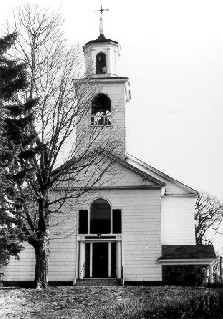
Although non-denominational at its inception, the congregation voted to adopt the Unitarian faith and thus became the first church of that denomination in Newton. In the first years the ministers were Unitarian. However, in 1832 we find that the members “voted that the money that may be received, be appropriated for the support of Unitarian and Universalist sentiments as each subscriber shall dictate.” This division, of course, was resolved when the Universalists built their own church in the village a few years later. Included in the 32 petitioners to the state legislature for permission to organize as a church were local factory owners and officials as well as prominent landowners and merchants from all sections of the village. Among the first group were Otis Pettee, Superintendent, and Frederick Cabot, Resident Agent, both of the Elliot Mfg. Co. There were also Newell and Rufus Ellis, owners of the Newton Factories. Among the second group was Bethuel Allen, landowner on Woodward Street, relative or close friend of Ralph Waldo Emerson in whose home Emerson and his mother lived in 1833-34. Because of the connection, shortly after Emerson was ordained a Unitarian minister in 1829, he was persuaded to preach in the new church on two occasions. The wife of Geoffrey Wheelock, a charter member of the Society, is believed to be Emerson’s cousin, the daughter of his mother’s sister, Mary (Haskins) Ladd. She is known to have resided in Newton.
Available records of the Society show a male membership of 145 during the years 1828 through 1833 (see chapter THE PEOPLE). While it is understood that most of these were employees of the industries which sponsored the building of the church, there were others from the outer perimeter of the village which had no association with these firms. Among the seven or so families from the northern section (now Waban) were the Turners, Collins, Wiswalls, Allens and Woodwards. Among the petitioners in the organization of the Upper Falls Meeting House were Matthias Collins, William Wiswall 2nd and the aforementioned Bethuel Allen. In 1832 the use of the church building as a Methodist church was granted to Marshall S. Rice, a Society member. The two organizations continued in joint operation until 1836 although Mr. Rice had purchased the building in 1832. Some of the members of the Religious Society joined the newer congregation.
First Methodist Episcopal Church
A Methodist preacher, Reverend Joel Steele, formed the first Methodist religious class at Newton Upper Falls in 1826, but because of unsettled conditions it was discontinued. Two years later, through the addition of members from Needham, another class was formed and on November 11, 1832 the church was organized with 53 members.

As stated previously, Marshall S. Rice personally bought the property of the Upper Falls Religious Society (Unitarian Church) in 1832 for the sum of $2,660 after some agonizing moments prior to its purchase. He was to state later:
“Before the year 1832 was ended, after we were permitted to occupy the house every Sabbath, and saw it was well filled, the question arose about owning it. I had partly paid for my home only; but I concluded to purchase it for the Society, if my wife would give her consent…I explained it to my wife, and asked her what she would do with our three little ones, if I should give my obligations for the house, and should then die? She answered, ‘Buy the house! I don’t believe you will soon be called to die, if you do; and should it be so, I will support our children by going into the factory to work, if necessary.’ The answer settled the question. I first purchased the 61-100 of the Elliot Manufacturing Company, and soon afterwards the 39-100 of Mr. Ellis; the amount paid for the house was $2,660. After the house had been enlarged and otherwise improved, the property was conveyed to the Trustees of the First Methodist Episcopal Society of Newton, in the year 1836.”
Mr. Rice organized the Sabbath School in July, 1832, and remained its superintendent for 47 years until his death. He was the church’s liberal benefactor despite the fact that he moved to Newton Centre where he became one of its more prominent citizens. He was Selectman and the Town Clerk of Newton for 27 years, holding this office (the last in that, capacity) until the town became a city. He was also a Representative to the General Court for four years. It is believed that the reason for Mr. Rice’s presence in Upper Falls in 1826 was because the family home was located here for a number of years (see chapter OLD HOUSES & BUILDINGS). Of interest is the fact that when the Upper Falls Methodist Church helped to organize the Newton Centre Methodist Church in 1877, it was Mr. Rice who was the chief benefactor, donated $1,000 to the enterprise. A more complete biography of Marshall S. Rice may be found under BIOGRAPHIES.

The church building was enlarged in 1836 when the walls were sawed in two, the rear end moved back and 20 pews inserted in the center. The interior of the church was also much improved. The large clock in the church was given by Joseph C. Everett in 1847 and. although some of the works have been replaced, it is still operating. The old horse sheds, since demolished, were erected in 1848 “by the eight men who were to have use of them.” The vestry was added to the church in 1857. The two rock maple trees (one of which was recently removed) which long stood in front of the church were pulled up out of the grass as seedlings in New Ipswich, New Hampshire about the year 1835 and brought to Newton by Mr. Rice in the chaise-box of his carriage. Three similar trees planted in front of Mr. Rice’s home in Newton Centre have the same history.
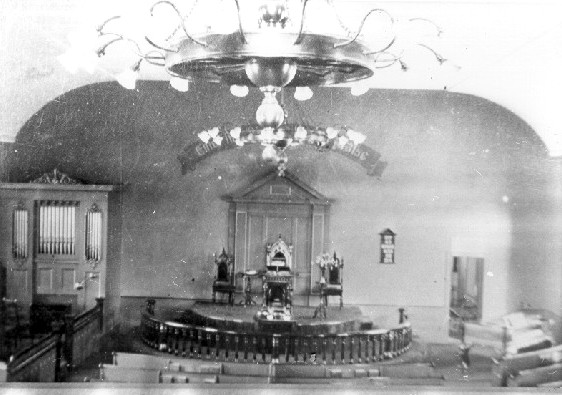
The old church parsonage at 91 High Street was purchased in 1865 from John Hunt (former owner Benjamin Davenport) and sold in 1950 to John Simpson for slightly more than $8,500. In 1949 a new parsonage was erected at the cost of about $19,000 at 5 Summer Street, replacing two dwellings which formerly stood at 3 and 5 Summer Street. During the early 1920s, through volunteer work by the parishioners, a basement was dug out from under the church and a kitchen, parlor, a large hall and a new steam heating plant were installed. At about this time the church received one of its largest bequests, from the estate of Orlando Davenport. Robert McLaughlin says:
“Mr. Davenport’s family was at one time connected with the Newton Iron Works and he, as a boy, lived on the corner of Pettee and High streets where the Pettee (Prospect) block now stands…The family moved to Cambridge and were successful as carriage builders (see story in INDUSTRY chapter regarding Davenport; railway car builders). However, Mr. Davenport’s generosity was the direct result of a warm friendship for Mr. Charles Brown whose family had been active in the church’s affairs for three generations. This friendship fostered a love for the village which resulted in the bequest.”
While the foregoing is quite true, it is also a fact that three brothers named Joseph, Benjamin J. and Alvin Davenport, all Orlando’s ancestors, were members and organizers of the old Upper Falls Religious Society in 1828. They were later members of the Methodist Church. Among the noted preachers serving the church were the Reverend Francis J. McConnell who rose to be Bishop in the Methodist Church. Miss Sadie Hagen, also a member, was one of the Deaconesses who helped build the Palmer Memorial (Deaconess) Hospital in Boston.
The local church is the first Methodist Church in Newton, and at this writing is the second oldest church building still standing in Newton. From it have sprung the following churches: Watertown in 1838; Lower Falls in 1838*; Highlandville (Needham Heights) in 1867 and Newton Center in 1877. The Newtonville Church came from the Watertown Church in 1857.
* The Lower Falls Church called the Perrin Memorial, was the “founding” church of the Christ United Methodist Church of Wellesley. Later, merging with this church, the Lower Falls building was sold to the Greek Evangelical Church, which occupied it for a short time before selling it to a business firm. The old church at Lower Falls, after being used for commercial purposes was condemned to destruction and the owners have used the site for business purposes.
Second Baptist Church
Second Baptist Church was an offshoot of the First Baptist Church at Newton Centre and began as a joint enterprise with the Congregationalists. Two prominent members of the First Congregational Church at Newton Centre, Deacons Elizah F. Woodward and Asa Cook, assisted in the founding of the church. They and other members of their faith joined in services in the autumn of 1830 conducted alternately by Congregational and Baptist ministers. Jonathan Bixby, Jr., grandson of the pioneer mill owner, appears to have been the principal patron of the enterprise. Part of an interesting story of the early days of the church is told by the daughter of Mr. Bixby:
“During the autumn of 1830, meetings for preaching were held in the schoolhouse…One Sunday morning, when the people had come together to hear the Rev. Mr. Bates…the person who, as committee-man of the district, had charge of the schoolhouse, refused to give up the key to the house, affirming that he did not deem it his duty to open the building on the Sabbath for religious services. Under these circumstances Mr. D.L. Brayton, a member of the Theological Institution… being present, in order to meet the exigency immediately applied to Mr. Jonathan Bixby, who at once opened his doors to the people…Mr. Bixby was just recovering from a rheumatic fever, and unable to leave his room; so that the privilege of enjoying the services w as brought, without his seeking it, to his bedside. For months afterwards, Mr. Bixby’s house was a house of worship…on the Sabbath evenings. In the spring of 1831, Mr. Bixby fitted up a room in an adjoining building, which had been occupied as a store, for a place of religious worship, and the room was used for this purpose till ampler conveniences were provided.”
An additional paragraph in Miss Bixby’s record raises the question of whether there was a conflict between the Baptists and the Congregationalists over the erection and operation of a new meeting house, as we read:
“In the summer and fall of 1831, members of the Congregational Society built a vestry, and during the following year, the Baptists erected their chapel, which was dedicated in March, 1833.”
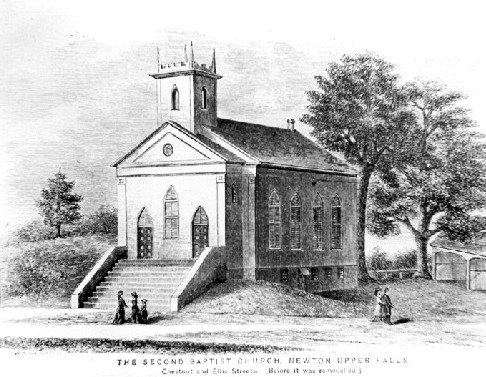
A question naturally arises here. Did each organization build a separate building? If there were two buildings, the location of the vestry is unknown. There is one clue since in the 1840s Ebenezer Woodward conducted a private school in a building on the southwest corner of High and Winter Streets. The building was called the ‘vestry.’ During its final use as Collin Cady’s tin-shop, it burned to the ground July 31, 1869.
The Baptist Chapel was built in 1832 by 11 persons buying 20 shares, most of them purchased by Jonathan Bixby. Four other Bixbys are listed as charter members when the church was organized (a complete list is included in THE PEOPLE chapter). In 1833, public services commenced on Sundays and were conducted by students of the Newton Theological Institute. Although the meeting house was dedicated March 27, 1833 it was not organized as a church until February 8, 1835 with 55 members, most of them coming from the First Baptist Church in Newton Centre.
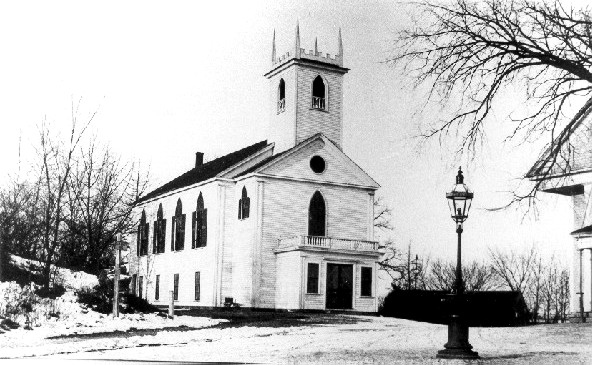
In the fall of 1835 the chapel was enlarged and improved, and Reverend Origen Crane of Connecticut became the first pastor, remaining three years. In 1865 under the leadership of Reverend W.C. Richards, pastor from 1865 to 1871, the church was repaired and improved. The land was removed from about the building and the basement floor lowered, thus increasing the height of the rooms. An entrance to the church was then built at ground level to replace the broad and high outside stairway used previously. The church bell was also purchased in that period from the Newton and Watertown Universalist Society for the sum of $500. Among the noted preachers serving the church was Reverend S.F. Smith, D.D., composer of the famous patriotic hymn, “America”.
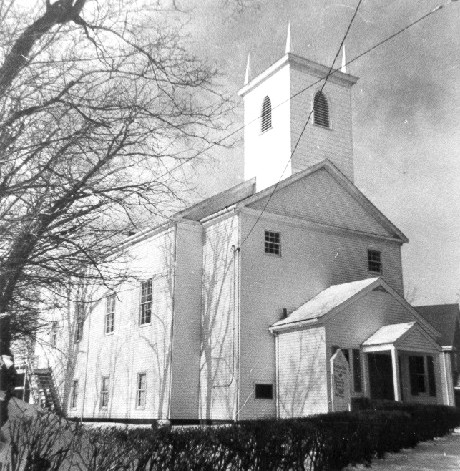
Second Baptist Church is now the third oldest church still standing in Newton.
St. Mary’s Roman Catholic Church
About 1843 or 1844 the first Catholic Mass celebrated in Newton was at Newton Upper Falls, conducted by Reverend Father Strain of Waltham.
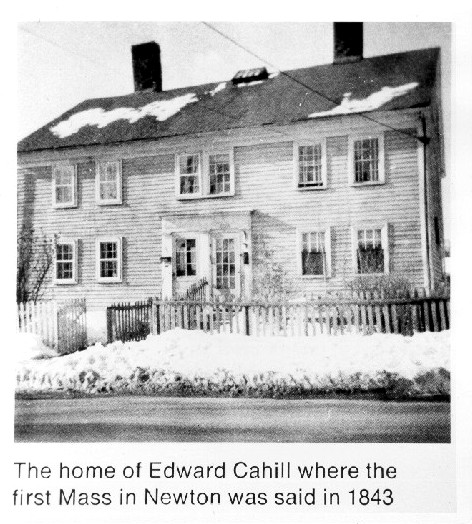
Others had come before him to attend the sick as well as render other services, but he appears to have been the first to hold religious services here. His chapel was a room in the mill house of Edward Cahill near the northwest corner of Chestnut and Elliot Streets. It was located on the property of Otis Pettee’s Elliot Mills, a fact verified by his granddaughter, the late Mrs. Grace Carey of Newtonville. Her father, James Cahill, was a prominent contractor and later one of the leaders in the church. Mrs. Carey leaves us with an amusing anecdote concerning her father:
“When he was sixteen years of age he worked as a water boy in the mills behind his home, carrying water from the well at the northerly end of the mill yard to the ‘bobbin’ girls in the factory. One hot and sultry day in August, 1862 he was drawing water from the well when he heard a fife playing the lilting tune of ‘The Girl I Left Behind Me.’ Rumbling down Chestnut Street was a horse-drawn dray with ‘old’ Flagg in the driver’s seat trying to sign up recruits for the Civil War. With out a moment’s hesitation Jimmie Cahill threw his bucket into the weeds and went off to war. He was to go through many battles unscathed, re-enlisting in January 1864 and finally being mustered out on June 29, 1865. His father had died in 1863 so when he came home he went to live with a tentmate of the war on the Needham side of Upper Falls.
The bodies of Edward Cahill and his wife, Margot, were moved from the cemetery at Piety Corners, Waltham to St. Mary’s Cemetery in Needham in April, 1877.”
Father Strain was succeeded by Father Patrick Flood who also held services in the same room as his predecessor. However, by 1860 the congregation had grown to about 300 and was meeting in Elliot Hall, the former Universalist Church on High Street. Prominent among the leaders of the congregation were James Cahill, Patrick Hurley, Michael Begley and Michael Daley. In 1867, with church funds amounting to about $7,000 and $3,000 raised by mortgage, a church, 40 X 76 feet in size, was built on an acre of land on Chestnut Street which had been purchased during the pastorate of Father Bernard Flood. It was the first Catholic church in Newton and was dedicated November 17, 1867.
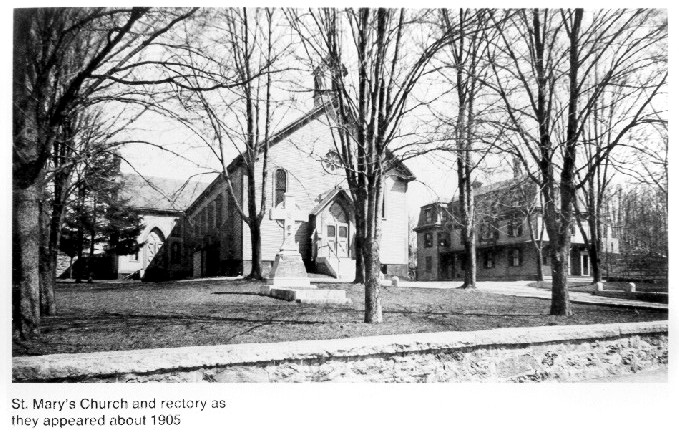
In 1875 a transept, 40 X 80 feet, having a gallery at each end was added to the church, increasing the seating capacity to 1,000. A basement was also extended under the whole church. The average attendance of the church at that time was about 750 and the parish, embracing Needham, Upper and Lower Falls and Newton Centre as far as Beacon Street included about 1,000 to 1,200 Catholics.

During this time land was purchased on Hale Street for possible use as a site for a convent and school, a plan later abandoned and the land sold. Also acquired by the church was a pasture on Chestnut where a carriage shed and barn for a cow and horses was built. In 1872, about 30 acres of land, bounded by Wellesley Avenue, Cedar and Hunnewell Streets, and located in the towns of Needham and Wellesley were purchased to become what is now known as St. Mary’s Cemetery.
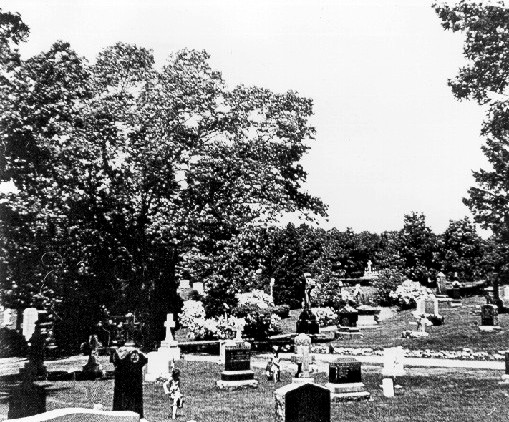
After the turn of the century the property on Chestnut Street was sold and the present site on Elliot Street, then occupied by the home of Dr. McOwen, was purchased. The house was moved further down Elliot Street and the corner stone of the new church, to be known as Mary Immaculate of Lourdes, was laid October 3, 1909. The cost of the building was $150,000.
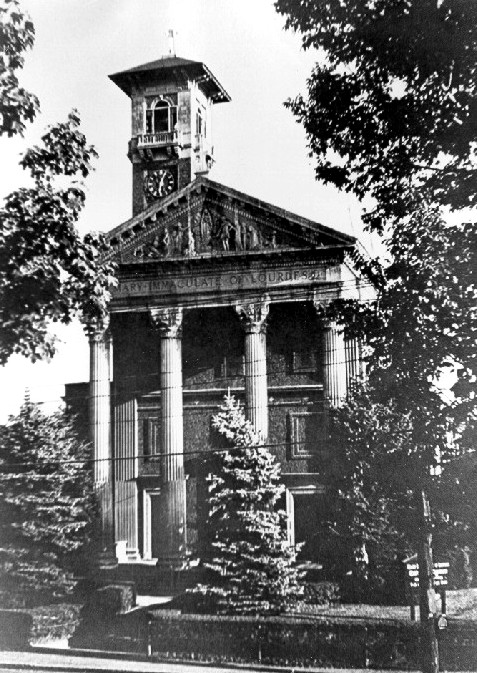
The new rectory beside the church was built about 1940, and the Dr. McOwen house adjacent to it was made into a parish center. Later it was remodeled and named the St. Elizabeth Center. St. Joseph’s Church in Needham, St. John’s the Evangelist in Wellesley Lower Falls, Sacred Heart in Newton Centre and St. Philip Neri Church in Waban all sprang from Mary Immaculate of Lourdes, and these newer parishes have greatly reduced the once wide scope of the mother church.
Universalist Society
A society of the Universalist denomination was organized for religious worship at Newton Upper Falls in September, 1841. A meetinghouse, the first of the Universalist faith in Newton, was erected on High Street at a cost of about $1,300 and was dedicated in May, 1842.

There were 22 original proprietors listed as organizers of the church and leading the list was Pliny Bosworth, a shop owner who had just completed the building of a machine shop on High Street. A list of the church members may be found in the chapter THE PEOPLE. The first and only pastor was Reverend Samuel P. Skinner who served the church until October, 1845. When a feud developed between West Newton and Newton Centre as to which village should be the seat of the town government, producing such high feelings that it was almost decided to divide Newton into two towns, it was the persuading influence of Reverend Skinner’s eloquence that kept the old town together. Our young Upper Falls schoolboy, John Winslow, gives us this eye-witness account of those exciting days:
“Town meeting day was an occasion when boys with public spirit would go to meeting and not to school. How well do I remember the old town meetings held in the Town Hall at Newton Centre, near the Baptist Pond. When the question of dividing the town was up it caused many hot debates in town meeting. Two prominent advocates of the proposed division were the Hon. William Jackson of the ‘Corner’ and Seth Davis of West Newton, which latter place in early days was impolitely called ‘Squash h End.’ Two prominent opponents of division were old Mr. Edwards and the Rev. Samuel Skinner. Mr. Skinner was a ready and able debater, and rather too much for his adversaries. The long contest finally came to an end and the good town was not divided. You may believe that we boys who attended the town meetings had decided opinions on the momentous question.”
After Reverend Skinner, the Universalist pulpit was supplied by A.S. Dudley, a dentist by profession, until July 1847. It was then filled by Dr. William F. Teulon of Huguenot ancestry, and long a physician at Upper Falls, West Newton and Newton. Although the Society was dissolved after an existence of only six or seven years, its church building continued to serve as a useful structure in the village, taking the name of Elliot Hall. In 1879 the building was sold to a local grocer, John Hove, who turned it a quarter turn and converted it into a private residence.
Church of Yahweh
This church was built on Boylston Street sometime in the 1880s. It was not a Jewish congregation as the name might imply, but consisted of 25 persons who shared the beliefs of the Second Adventists. They formed the church in the spring of 1886 and followed it a few years later with a Sunday School. Before the year of organization was over, a chapel was built and dedicated, and services were conducted every Sunday afternoon. Historians agree when they stated that a chapel was built on the property of Luther T. Cunningham on Boylston Street, and Robert McLaughlin says in his local history:
“An edifice was built which contained an auditorium or meeting house, a home for the minister (Martin Cunningham) and a provision store which was managed by the minister. This building still stands at 1276 Boylston Street but has be en remodeled into a two family residence.”
The above, however, presents a small mystery as an official Newton atlas of the year 1874 shows a store on the extreme northwest corner of Mr. Cunningham’s property, and succeeding atlases of 1886 and 1895 show no additional buildings.

Could it be that the store was just remodeled for religious purposes?
Mr. McLaughlin goes on to say that the congregation was largely made up of members of three families, mostly related to each other – the Cunninghams, the Pipers and the Adamses. Luther T. Cunningham was a blacksmith. Samuel A. Piper was a carpenter and built many of the homes in the community including his own which was on the southwest corner of Boylston and Chestnut streets. An addition to the basement was fitted up to be a waiting room for the Boston & Worcester Street Railway. However, they refused to subsidize it and after a few years as a store, featuring pastry and candy, it was closed. Mr. Adams worked locally as a pattern maker. Many of the children of these families became school teachers and moved away. Other members were lost by death, and the shifting population of the village did not bring strength to the church. In spite of subsequent efforts to propagate the faith, Second Adventism failed to perpetuate itself in the village, and it is presumed that the large and flamboyant name plate and inscription on the front of the building which had attracted attention slowly faded away.
News accounts from the latter part of the nineteenth century record the rise and ‘ebb’ of the local churches’ fortunes. Their cultural contributions in the form of visiting lecturers and the recording of baptisms, weddings and funerals within their walls as well as the social affairs, picnics and other functions make interesting and informative reading. Among them we find the following methods used in earlier days to finance the cost of operating our churches.
“…William Palmer, Ichabod Mason, Warren Dewing, Michael McIntosh and Fisher Mills, Trustees of the Upper Falls Religious Society and the Methodist Episcopal Church in Newton Upper Falls having been duly elected and legally qualified to that office, do by these presents, and by virtue of the powers vested in us, in consideration of ninety three dollars…paid to us by Otis Pettee of Newton the receipt whereof we do hereby acknowledge, do hereby grant, sell, and convey unto the said Otis Pettee, his heirs and assigns for ever, the pew numbered thirty five…”
The preceding was subject to certain conditions including this one:
“Should the above named Methodist Chapel be consumed by fire the owner of this Deed shall receive his proportional part of the money that may be received from the Insurance Office.”
The above was handwritten into the formal and printed document. The complete document was signed by four of the trustees, witnessed and duly notarized by Ebenezer Cheney, Justice of Peace. It was dated May 4, 1836.
In another part of Newton and at a much later date, we note this advertisement appearing in the Newton Journal of January 9, 1886. During the 50 years which had elapsed since the completion of the transaction previously described there seems to have been an increase in the use of church pews:
| Pew in Eliot Church FOR SALE No. 141, Appraised Value, $175.00 No. 144, ” ” $375,00 Best locations in North Aisle PO Box 307, Newton |
Relative to our village churches, it should be stated that complete histories of the First United Methodist and Mary Immaculate of Lourdes churches are available in the offices of both parishes.
